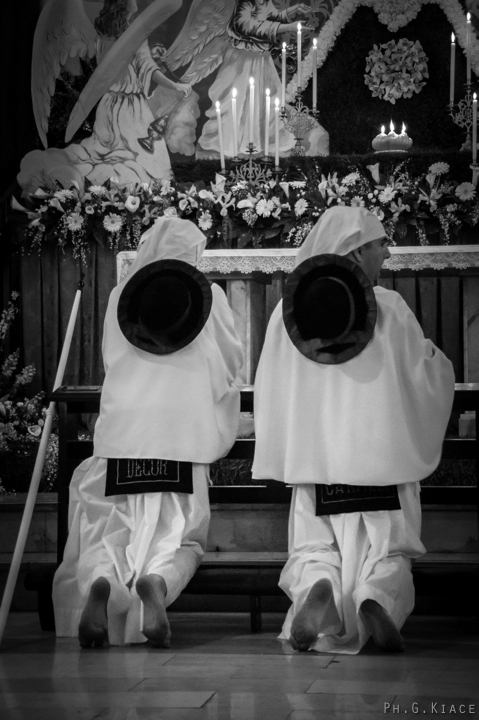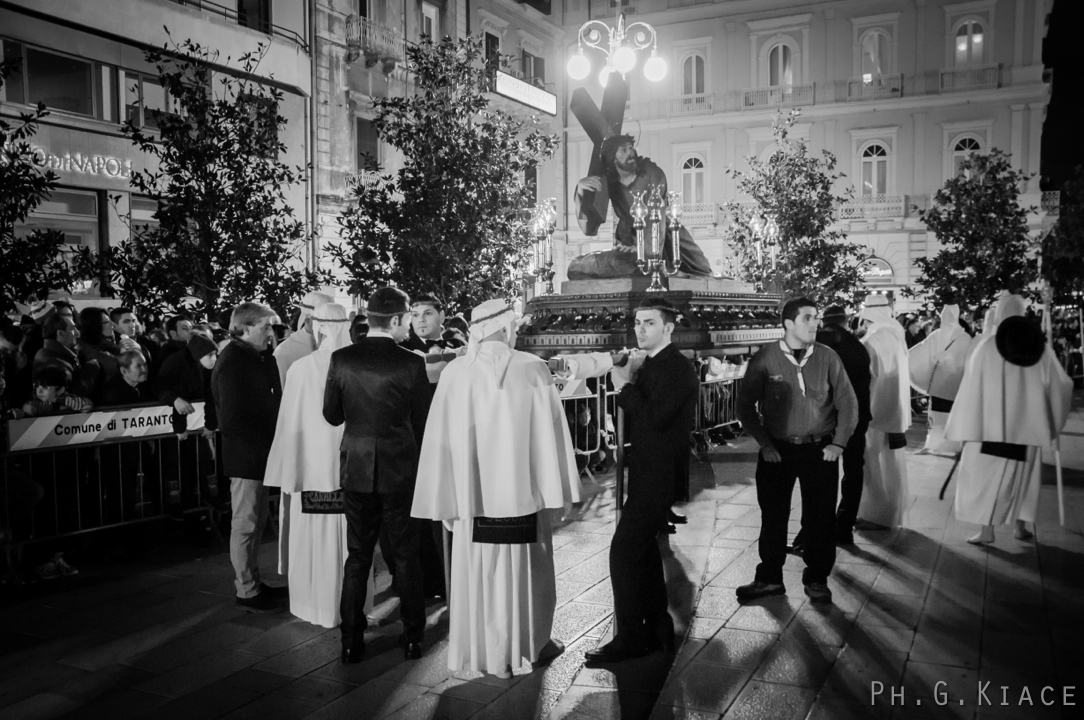La settimana Santa a Taranto
Holy Easter week in Taranto (Italy)
Le Perdúne
_
I riti della Settimana Santa di Taranto sono un evento che si svolge nella città a partire dalla Domenica delle palme e risalgono all'epoca della dominazione spagnola nell'Italia meridionale. Furono introdotti a Taranto dal patrizio tarantino don Diego Calò, il quale nel 1603, fece costruire a Napoli le statue del Gesù morto e dell'Addolorata.
Questo progetto descrive la figura dei pellegrini di Taranto, chiamati Perdoni, Perdùne in dialetto tarantino, vero simbolo della processione dei misteri della città di Taranto.
I Perdoni durante il loro pellegrinaggio portano con sè una mazza alta circa due metri che simboleggia l'antico bastone dei pellegrini: infatti le Perdúne vengono così chiamati in ricordo dei pellegrini che si recavano a Roma per ottenere il perdono dai loro peccati; il loro nome deriva dalla deformazione dialettale di "bordone", cioè del nome del bastone uncinato che usavano i pellegrini.
Durante il loro pellegrinaggio i Perdoni, incappucciati e scalzi, eseguono un vero e proprio cammino di fede e dolore per rivivere il sacrificio della croce per ben quattordici drammatiche ore, visitando i sepolcri allestiti nelle diverse chiese della città.
I Perdoni si muovono sempre in poste, coppie di Confratelli del Carmine, e, con il loro abito tradizionale e il loro lento incedere caratterizzato dalla nazzicata, "nazzecata" in tarantino, ovvero da un dondolio continuo.
I Perdoni durante il loro pellegrinaggio portano con sè una mazza alta circa due metri che simboleggia l'antico bastone dei pellegrini: infatti le Perdúne vengono così chiamati in ricordo dei pellegrini che si recavano a Roma per ottenere il perdono dai loro peccati; il loro nome deriva dalla deformazione dialettale di "bordone", cioè del nome del bastone uncinato che usavano i pellegrini.
Durante il loro pellegrinaggio i Perdoni, incappucciati e scalzi, eseguono un vero e proprio cammino di fede e dolore per rivivere il sacrificio della croce per ben quattordici drammatiche ore, visitando i sepolcri allestiti nelle diverse chiese della città.
I Perdoni si muovono sempre in poste, coppie di Confratelli del Carmine, e, con il loro abito tradizionale e il loro lento incedere caratterizzato dalla nazzicata, "nazzecata" in tarantino, ovvero da un dondolio continuo.
L'abito tradizionale dei Perdoni è caratterizzato da un camice bianco stretto in vita e sui polsi; un rosario nero appeso in vita con medaglie sacre ed un crocifisso, pendenti sulla destra del camice; una cinghia di cuoio nero attaccata in vita e fatta pendere sul lato sinistro del camice, rappresentante la frusta che colpì Gesù; una mozzetta color crema abbottonata sul davanti; due scapolari recanti rispettivamente le scritte ricamate "Decor" e "Carmeli" in seta blu chiaro; un cappuccio bianco con due forellini all'altezza degli occhi; un cappello nero bordato con nastro blu chiaro, dai cui lati scendono altri due nastri anch'essi blu, indossato in testa sul cappuccio o appoggiato sopra le spalle, fissato in vita con un nastro che viene fatto passare attraverso un'asola che si trova nell'abbottonatura della mozzetta e guanti bianchi di cotone o di pelle.
The rites of Easter Holy week in Taranto, a city in south east of Italy, start from Palm Sunday and end on Good Friday. They belong to Hispanic Domination era and was introduced in Taranto from don Diego Calò, who built in Naples the statues of died Jesus and Lady of Sorrows.
This project describes the figure of pilgrims of Taranto, called “Perdoni”, “Perdùne” in local dialect, who are the real symbol of the Mysteries procession of Taranto. “Perdoni” during their pilgrimage bring a big mace, with an height of about two meters, which is the symbol of the ancient pilgrims’ mace: “Perdoni” are so called to remember pilgrims who went to Rome to obtain redemption from their sins. Their name comes from the dialectal deformation of “bordone”, which is the name of the mace used by pilgrims.
The pilgrimage of the “Perdoni”, who are hooded and barefooted, is a real journey of faith and sorrow and it’s a way to relive the sacrifice of the cross for fourteen painful and dramatic hours, visiting all sepulchres prepared in city’s churchs.
The “Perdoni” always moves in pairs with their traditional dress and have a very slow walk, characterized by the “nazzecata”, which in local dialect is the typical swinging movement of their walk.
The traditional dress of “Perdoni” is characterized by a white coat cinched at the waist and wrists; a black rosary hanging at the waist with sacred medals and a crucifix hanging on the right side of the gown; a black leather strap attached at the waist and slanted to the left side of the gown, representative of the whip that struck Jesus; a cream-colored mozetta buttoned at the front; two scapulars bearing the embroidered words "Decor" and "Carmeli" in light blue silk; a white cap with two holes to eye level; a black hat edged with light blue ribbon, from which descend the sides other two tapes also blue, worn on the head on the cap or leaning over the shoulders, fastened at the waist with a tape that is made to pass through a slot that is located in 'placket of mozetta and white cotton or leather gloves.


























